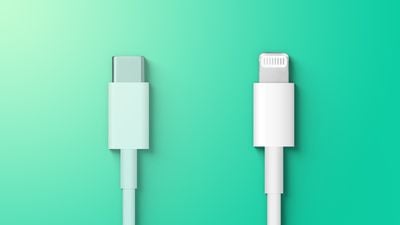When Phil Schiller introduced the Lightning connector at the unveiling of the iPhone 5 in September 2012, he called it "a modern connector for the next decade," and with that 10-year mark coming up later this year, questions remain over what the future of the iPhone looks like and whether or not that future will include a Lightning port, or perhaps no port at all.

Every iPhone since the iPhone 5 has featured a Lightning port, which Apple touted in 2012 as a "smaller, smarter and more durable" port compared to the previous 30-pin connector. Even as the majority of the company's iPad line and the entire Mac line now feature USB-C, the iPhone has become the odd one out with its inclusion of Lightning.
The smartphone industry has rapidly transitioned to USB-C, with the vast majority of handsets on the market featuring the more versatile port. Apple's reluctance to follow the industry in adopting USB-C has annoyed many customers, but it appears Apple is sticking with Lightning on iPhone for the considerable future.
Apple analyst Ming-Chi Kuo, who frequently shares accurate insights into Apple's product plans, has said the company believes the adoption of USB-C would negatively impact its Made for iPhone (MFi) program and notes that Apple is concerned about lower standards of water resistance for USB-C compared to Lightning. Given those two points, Kuo says the iPhone will continue to feature Lightning for the "foreseeable future."

Apple's ultimate goal for the iPhone is to go completely portless, relying on MagSafe and wireless connections for charging and data transfer needs. MagSafe on the iPhone, which first debuted on the iPhone 12, is still not fully matured and is so far limited to charging. Apple is highly unlikely to abandon Lightning and adopt USB-C for only a few years before going portless. Instead, it's more likely to use Lightning while continuing to MagSafe matures for a future portless iPhone.
The European Commission could, however, impact how soon we get a portless iPhone. The EC has proposed a directive that would require all consumer electronic devices, including smartphones, tablets, cameras, headphones, portable speakers, and handheld videogame consoles, to feature a "common port," aka, USB-C. If the directive does pass in 2022, companies such as Apple will have two years to transition their devices to USB-C.
There are some caveats, though. On paper, the directive would constitute a significant change for the iPhone as it would be forced to include USB-C, but the directive only applies to devices that charge via cable.
A spokesperson for the EC confirmed to The Verge that if a device exclusively charges via wireless charging, it isn't required to include a USB-C port. That, alongside the two-year transition period that the directive would allocate to companies to transition to USB-C, gives Apple ample time to mature MagSafe and abandon Lightning in favor of an all-wireless future.
Apple's confusing port lineup has not gone unnoticed. Across the latest iPhone, iPad, MacBook Pro, Apple Watch, and AirPods models, Apple offers customers four completely different types of chargers to juice up their devices. Bloomberg's Mark Gurman highlighted the inconsistency in his Power On newsletter this past August. As Gurman noted at the time, "Lightning served Apple well since 2012, but USB-C has clearly won out across the industry and has become the default connector for new devices."























